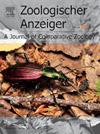Speciation on the continent in the Miocene? Multiple overseas dispersal to the island? –Reexamination of diversification process of Kurixalus eiffingeri (Boettger, 1895) (Amphibia: Rhacophoridae)–
IF 1.5
3区 生物学
Q2 ZOOLOGY
引用次数: 0
Abstract
To clarify the genetic differentiation of a small tree frog species, Kurixalus eiffingeri complex from the Yaeyama Islands and Taiwan, phylogenetic analyses were conducted using the partial mitochondrial DNA sequences. K. eiffingeri was divided into four major lineages: Ishigaki, Iriomote, Central Taiwan, and Northern Taiwan. The Ishigaki and Iriomote lineages were combined as the Ryukyu clade, which is sister to the Northern Taiwan lineage, and these together were outgrouped by the Central Taiwan lineage. The expansion of Kurixalus into Taiwan is estimated to have occurred twice, the first 4.75–6.70 million years ago by the common ancestor of the K. eiffingeri species group, and the second in the Late Pleistocene (0.33–1.11 million years ago) by the ancestor of the Kurixalus idiootocus species group. The K. eiffingeri species group diverged into Kurixalus wangi and Kurixalus berylliniris, and Central and Northern Taiwan lineages through the uplift of the mountain range of Taiwan, and then the Northern Taiwan lineage spread to the Yaeyama Islands (including Ishigaki Island, Iriomote Island and son on) during the Early Pleistocene through a land bridge. The divergence time between the Ishigaki and Iriomote lineages was much older than the age of the Last Glacial Maximum (LGM). Thus, their genetic differentiation was maintained even the two islands were connected during the LGM.
中新世大陆的物种形成?多次海外分散到岛上?- - - - - - - - - - - - - - - - - - - - - - - - - - - - - - - - - - - - - - - - - - - - -
为了明确台湾八山群岛小树蛙(Kurixalus eiffingeri complex)的遗传分化,利用部分线粒体DNA序列进行了系统发育分析。艾氏家蚕被划分为四个主要的世系:石垣、伊洛莫特、台湾中部和台湾北部。石垣和Iriomote谱系被合并为琉球分支,它是台湾北部谱系的姐妹,而这些分支一起被台湾中部谱系所取代。据估计,Kurixalus曾两次进入台湾,第一次是在475 - 670万年前,由K. eiffingeri种群的共同祖先,第二次是在晚更新世(0.33 - 111万年前)由Kurixalus idiootocus种群的祖先。早更新世,北台湾种群通过陆桥向八山列岛(包括石垣岛、怡罗得岛等)扩散,并在台湾山脉的隆升中分化为王木树和柏树树,以及台湾中部和北部种群。石垣系和Iriomote系的分化时间远早于末次盛冰期(LGM)。因此,即使两个岛屿在LGM期间连接,它们的遗传分化也保持不变。
本文章由计算机程序翻译,如有差异,请以英文原文为准。
求助全文
约1分钟内获得全文
求助全文
来源期刊

Zoologischer Anzeiger
生物-动物学
CiteScore
2.80
自引率
7.10%
发文量
75
审稿时长
>12 weeks
期刊介绍:
Zoologischer Anzeiger - A Journal of Comparative Zoology is devoted to comparative zoology with a special emphasis on morphology, systematics, biogeography, and evolutionary biology targeting all metazoans, both modern and extinct. We also consider taxonomic submissions addressing a broader systematic and/or evolutionary context. The overall aim of the journal is to contribute to our understanding of the organismic world from an evolutionary perspective.
The journal Zoologischer Anzeiger invites suggestions for special issues. Interested parties may contact one of the editors.
 求助内容:
求助内容: 应助结果提醒方式:
应助结果提醒方式:


